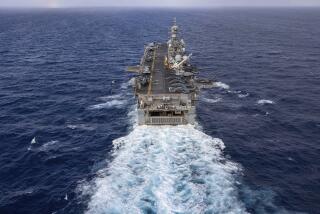New Military Wish List: Cargo Ships, Rail Cars
- Share via
WASHINGTON — At a time when virtually every other part of the defense budget is shrinking, the Pentagon’s top brass has been fanning across Capitol Hill, making the case for a new “mobility” blueprint that calls for construction of 20 military cargo ships and a fleet of specially designed rail cars.
In part, these requests reflect the new clout that Pentagon logistics chiefs are enjoying. Long considered the hobgoblins of combat planning, their achievements in the Persian Gulf War have made swaggering heroes of them.
More important, however, the proposals are the result of a comprehensive study of the Pentagon’s requirements for airlifts and and sea lifts at a time when virtually all the assumptions that guided U.S. military logistics planning have changed.
Since the disintegration of the Soviet Union, the wars of the future are expected to be relatively small and similar to last year’s Persian Gulf conflict. To make use of a smaller, worldwide network of staging bases, Pentagon planners say they need new ships and rail cars to speed U.S. supplies and equipment to foreign locations.
Iraqi President Saddam Hussein unwittingly gave the United States time to put its supplies in place by acting less swiftly than he had threatened to do--and might have done against another Mideast country. A future enemy might not be so lax.
Congress, which has a growing interest in the unglamorous subject of “airlift and sea lift,” last year added $200 million to the defense budget for construction of fast military cargo ships, and asked the Pentagon to devise a master plan for further expenditures.
At the Pentagon and at the military’s Transportation Command at Scott Air Force Base, Ill., the effort to draft a master plan forced close collaboration between the nation’s top logistics specialists and the officers who draw up plans for how the United States would fight wars all over the world.
Their conclusions, contained in a secret report 96 pages long--reveals much about where and what the U.S. military most expects to fight and how fast they expect to have to get there:
* A war in the Persian Gulf tops the likely scenarios in difficulty, and 20 new cargo ships would cut the deployment time of a Desert Shield-sized force from 180 days to 52 days, a Pentagon official involved in the study said.
* A war to help the South Koreans defend themselves from an attack from North Korea is considered the next-toughest scenario. A senior Pentagon official said that war games have demonstrated that the outcome of such a war might turn on the delivery of 100 tanks by ship within two weeks. As a result, they said, the Army needs to put enough equipment for a heavy armored brigade--roughly 100 tanks--or 2 million square feet of equipment--on nine floating warehouses, and position the ships somewhere in the eastern Indian Ocean, between Singapore and Diego Garcia.
* Also with an eye on Korea, the Pentagon recommended the development on the West Coast of an ammunition-loading facility capable of transferring containers from rail cars and trucks to ships.
Pentagon comptroller Sean O’Keefe told lawmakers recently that the Pentagon would soon send its proposal to Congress. That would guide the spending of $3.1 billion that Congress has earmarked for airlift and sea lift. The lawmakers are expected to sign off quickly on the Pentagon plan.
More to Read
Sign up for Essential California
The most important California stories and recommendations in your inbox every morning.
You may occasionally receive promotional content from the Los Angeles Times.














